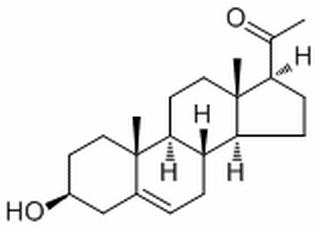Home
Products
Pregnenolone



| Product Name | Pregnenolone |
| Price: | $31 / 20mg |
| Catalog No.: | CN02584 |
| CAS No.: | 145-13-1 |
| Molecular Formula: | C21H32O2 |
| Molecular Weight: | 316.5 g/mol |
| Purity: | >=98% |
| Type of Compound: | Steroids |
| Physical Desc.: | Cryst. |
| Source: | The roots of Dictamnus dasycarpus |
| Solvent: | Chloroform, Dichloromethane, Ethyl Acetate, DMSO, Acetone, etc. |
| SMILES: | O[C@H]1CC[C@]2(C(=CC[C@@H]3[C@@H]2CC[C@]2([C@H]3CC[C@@H]2C(=O)C)C)C1)C |
| Contact us | |
|---|---|
| First Name: | |
| Last Name: | |
| E-mail: | |
| Question: | |
| Description | Pregnenolone acts as a signaling-specific inhibitor of cannabinoid CB1 receptor, reduces several effects of tetrahydrocannabinol (THC). |
| Target | CB1 Receptor Human Endogenous Metabolite |
| In Vitro | The effect of THC is significantly attenuated when slices are pre-treated with Pregnenolone 100 nM (15.1±1.8 % of inhibition). These effects are likely due to a pre-synaptic action of Pregnenolone. Thus, Pregnenolone blocks the increase in paired-pulse ratio (PPR) induced by THC but does not modify either the amplitude or the decay time of miniature EPSC (mEPSC)[1]. |
| In Vivo | Pregnenolone administration (2-6 mg/kg) blocks THC-induced food-intake in Wistar rats and in C57BL/6N mice, and blunts the memory impairment induced by THC in mice, but it does not modify these behaviors per se. Injections of Pregnenolone (2 and 4mg/kg) before each self-administration session reduce the intake of WIN 55,212-2 and reduce the break-point in a progressive ratio schedule[1]. |
| Animal Admin | Mice and Rats[1] Adult male Wistar rats (weighing 320-340g), Sprague Dawley male rats (weighing 330-350g), C57BL/6N mice (2-3 months) and CD1 mice (weighing 25-30 g at the beginning of the experiments) are used. Pregnenolone is injected subcutaneously (sc). The injection volumes are 1 mL/kg of body weight for rats and 10 mL/kg for mice[1]. |
| Density | 1.1±0.1 g/cm3 |
| Boiling Point | 443.3±45.0 °C at 760 mmHg |
| Flash Point | 188.9±21.3 °C |
| Exact Mass | 316.240234 |
| PSA | 37.30000 |
| LogP | 4.52 |
| Vapour Pressure | 0.0±2.4 mmHg at 25°C |
| Storage condition | 2~8℃ |